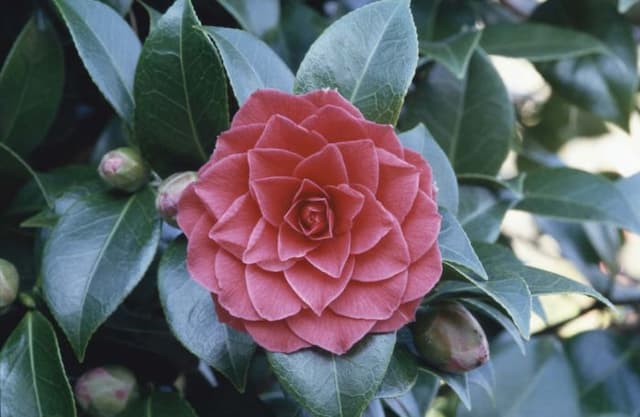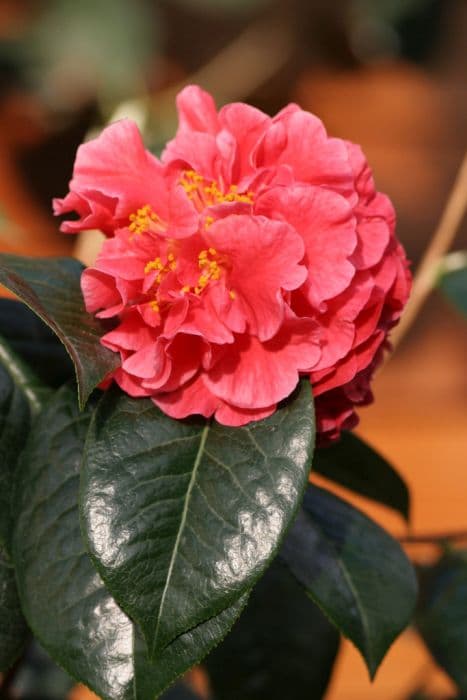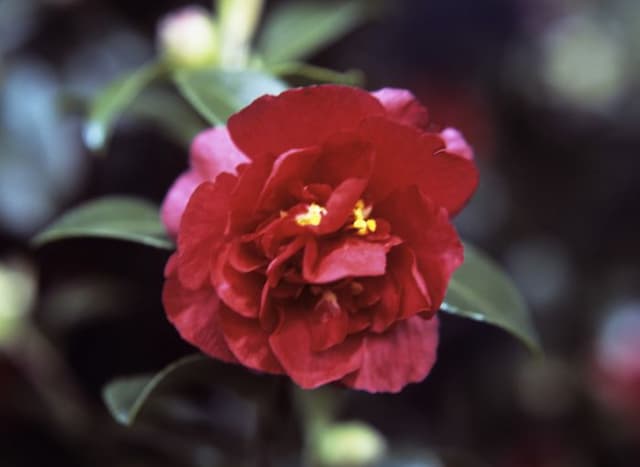Sasanqua Camellia Camellia sasanqua 'Narumigata'

ABOUT
Camellia sasanqua 'Narumigata' is an ornamental plant known for its elegant flowers and glossy, deep green foliage. Its leaves are oval-shaped with a slightly serrated edge, providing a lush backdrop throughout the year. The flowers are the real showstopper, boasting a single row of white petals, occasionally blushed with the palest pink at the edges, surrounding a prominent cluster of yellow stamens in the center, creating a striking contrast. These blooms emit a delicate fragrance that can enhance any garden setting. The arrangement of the petals is such that they form a loose, open cup shape, which adds a touch of grace to the overall appearance of the plant. This plant's blossoms emerge in the cooler months, bringing life and color to the garden when many other plants are dormant. Its elegant posture and delightful blooms make it a favored choice for ornamental planting and a beautiful specimen to behold in any landscape.
About this plant
 Names
NamesFamily
Theaceae
Synonyms
Sasanqua Camellia, Sasanqua, Christmas Camellia, Winter Camellia
Common names
Camellia sasanqua 'Narumigata'.
 Toxicity
ToxicityTo humans
The Camellia sasanqua, commonly known as Sasanqua camellia, is not considered toxic to humans. This means that ingesting parts of the plant typically does not lead to poisoning or adverse health effects.
To pets
The Sasanqua camellia is also not considered toxic to pets. Therefore, if pets ingest parts of the plant, it is not expected to cause poisoning or serious health issues. However, it's always a good idea to monitor pets for any unusual reactions after ingesting plant material, as individual sensitivity may vary.
 Characteristics
CharacteristicsLife cycle
Perennials
Foliage type
Evergreen
Color of leaves
Dark green
Flower color
White
Height
4-5 feet (1.2-1.5 meters)
Spread
5-7 feet (1.5-2.1 meters)
Plant type
Shrub
Hardiness zones
7
Native area
Japan
Benefits
 General Benefits
General Benefits- Ornamental appeal: Sasanqua camellia 'Narumigata' is valued for its attractive, delicate white flowers with a pink blush, which add aesthetic appeal to gardens and landscapes.
- Extended blooming season: Unlike other camellias, it blossoms in the fall, providing color and interest during a season when other plants may be dormant.
- Evergreen foliage: With glossy, dark green leaves, it provides year-round interest and structure in the garden.
- Drought tolerance: Once established, it is more drought tolerant than other camellia varieties, making it suitable for regions with less rainfall.
- Versatility in landscaping: It can be used in a variety of garden applications including hedges, screens, espaliers, or as a specimen plant.
- Beneficial to wildlife: Its flowers provide nectar for pollinators, making it a useful plant for supporting local ecosystems.
- Low maintenance: Requires minimal pruning and care once established, making it an easy choice for gardeners of all skill levels.
- Shade tolerance: It can grow in partial shade, offering a flowering option for darker parts of the garden where other sun-loving plants might not thrive.
- Resistance to pests: It is relatively resistant to common pests and diseases, reducing the need for chemical treatments in the garden.
- Container suitability: It can be grown in containers, offering flexibility for those with limited space or wanting to decorate patios and balconies.
 Medical Properties
Medical PropertiesThis plant is not used for medical purposes.
 Air-purifying Qualities
Air-purifying QualitiesThis plant is not specifically known for air purifying qualities.
 Other Uses
Other Uses- Privacy Screening: Camellia sasanqua 'Narumigata' can be grown as a hedge to provide privacy in gardens due to its dense foliage.
- Topiary Art: The plant's strong branches and evergreen leaves make it suitable for topiary, allowing gardeners to sculpt it into artistic shapes.
- Erosion Control: Because of its extensive root system, it can be planted on slopes to help stabilize the soil and prevent erosion.
- Bonsai: This camellia can be trained to grow as a bonsai, offering an aesthetically pleasing miniature landscape element.
- Perfumery: The subtle fragrance of 'Narumigata' flowers can be used in the creation of perfumes and scented products.
- Culinary Garnish: The flowers are edible and can be used to garnish salads and desserts, adding a splash of color and elegance to dishes.
- Ink and Dye: The petals of the flowers when crushed can potentially be used to create natural dyes for fabrics or inks for art purposes.
- Photography Backdrops: Because of its picturesque blooms, the 'Narumigata' camellia can serve as a beautiful backdrop for outdoor portrait photography.
- Symbolic Gift: In some cultures, camellias are symbols of love and devotion, and as such, 'Narumigata' may be given as a gift to express these sentiments.
- Floral Arrangements: The flowers can be used in both fresh and dried floral arrangements, providing an enduring decoration element with their longevity.
Interesting Facts
 Feng Shui
Feng ShuiThe Sasanqua Camellia is not used in Feng Shui practice.
 Zodiac Sign Compitability
Zodiac Sign CompitabilityThe Sasanqua Camellia is not used in astrology practice.
 Plant Symbolism
Plant Symbolism- Admiration: Camellias, in general, symbolize admiration, and 'Narumigata', with its delicate beauty, is often gifted to express deep respect and positive feelings towards another person.
- Perfection: The camellia’s symmetrical form and lustrous petals represent the pursuit of perfection in many cultures. 'Narumigata', with its near-perfect blossoms, echoes this symbolism.
- Longevity & Faithfulness: In the language of flowers, camellias often represent long-lasting devotion and eternal love, likely because they are evergreen and can bloom for a very long time. 'Narumigata' brings this meaning to life with its long blooming season.
- Love: In particular, the camellia is associated with romantic love. 'Narumigata', with its soft, romantic white petals, often signifies deep emotional connections and heartfelt admiration.
 Water
WaterSasanqua camellias require consistent moisture and should be watered deeply to keep the soil evenly moist but not soggy. Water the Sasanqua camellia when the top inch of soil feels dry to the touch; this typically means watering once a week. Increase the frequency during hot, dry periods to prevent stress on the plant. As a general guide, provide a sasanqua camellia with about 1 to 1.5 gallons of water per watering session to ensure that the moisture reaches the deeper root system. Adjust the amount and frequency based on local rainfall, temperature, and soil conditions.
 Light
LightThe Sasanqua camellia flourishes in partial shade to filtered sunlight, preferring a location that receives morning light and afternoon shade. An ideal spot is under high, dappled-light canopies of trees where direct sun exposure is limited, as this helps protect the foliage and flowers from intense midday rays. Full sun can be tolerated in cooler climates, but ensure the plant is shielded during the hottest parts of the day.
 Temperature
TemperatureSasanqua camellias are hardy and thrive in a range of temperatures but perform best when daytime temperatures stay between 60 to 80 degrees Fahrenheit and night temperatures do not drop below 40 degrees Fahrenheit. They can survive brief dips down to 20 degrees Fahrenheit but sustained cold below this can damage the plant. The ideal temperature range supports healthy bud development and flowering.
 Pruning
PruningPrune sasanqua camellias to maintain shape, remove dead or weak growth, and promote air circulation within the canopy. The best time to prune is just after the blooms have faded, typically in late winter or early spring, as this prevents cutting off next season's buds. Lightly shape the plant, focusing on thinning out dense areas, and removing any crossed or inward-growing branches. Pruning should be done annually or as necessary to keep the plant healthy and aesthetically pleasing.
 Cleaning
CleaningAs needed
 Soil
SoilSasanqua camellias thrive in well-draining, acidic soil with a pH between 5.5 and 6.5. A mix of 1/3 peat moss, 1/3 pine bark, and 1/3 perlite or coarse sand is ideal for ensuring good drainage and aeration while retaining moisture.
 Repotting
RepottingSasanqua camellias generally need repotting every 2-3 years. It's best to repot in the late winter or early spring before the new growth begins.
 Humidity & Misting
Humidity & MistingSasanqua camellias prefer moderate to high humidity levels, around 50-60%. They thrive when the surrounding air is moist, but not wet.
 Suitable locations
Suitable locationsIndoor
Ensure bright, indirect light and high humidity for indoor Sasanqua camellias.
Outdoor
Plant in partial shade with shelter from afternoon sun and wind for outdoor Sasanqua camellias.
Hardiness zone
7-9 USDA
 Life cycle
Life cycleCamellia sasanqua 'Narumigata', also known as Sasanqua camellia, begins its life cycle with seed germination, occurring in a moist, well-drained environment. After sprouting, it enters the seedling stage, where it establishes a root system and produces its first leaves. As it enters the juvenile phase, it develops a strong stem and foliage, but does not yet flower. Reaching maturity, Sasanqua camellia starts its reproductive stage, typically in its third year, producing fragrant white flowers with a pink flush from fall to winter. After pollination, it develops seed pods which, when mature, open to release seeds, completing the cycle. Throughout its life, which can span several decades, the plant goes through yearly cycles of growth, flowering, and seed production.
 Propogation
PropogationPropogation time
Early Spring
The most popular method of propagating the Camellia sasanqua 'Narumigata', commonly known as the Sasanqua camellia, is through semi-hardwood cuttings. This technique is typically carried out in late summer after the plant has finished its growth spurt and the new wood has begun to harden. You should select healthy, disease-free branches and trim cuttings approximately 4 to 6 inches (about 10 to 15 centimeters) in length. The ideal cutting should have several leaves but the lower half of the leaves should be removed to expose the nodes. Dip the cut end into a rooting hormone to encourage root development and plant the cutting in a mixture of sand and peat moss that is kept moist. Place the cuttings in indirect sunlight and wait for roots to develop which can take a few weeks to several months depending on environmental conditions.









